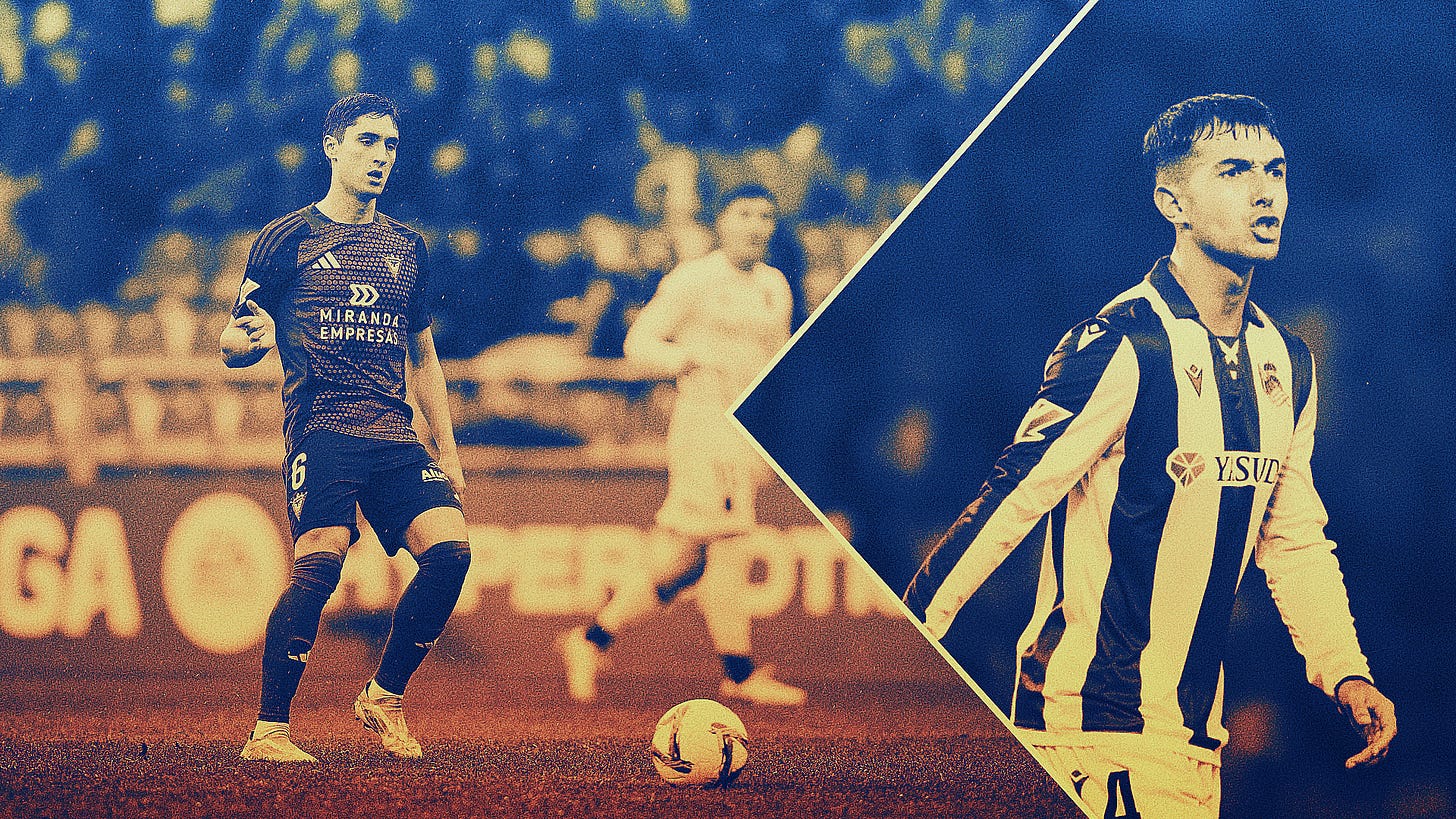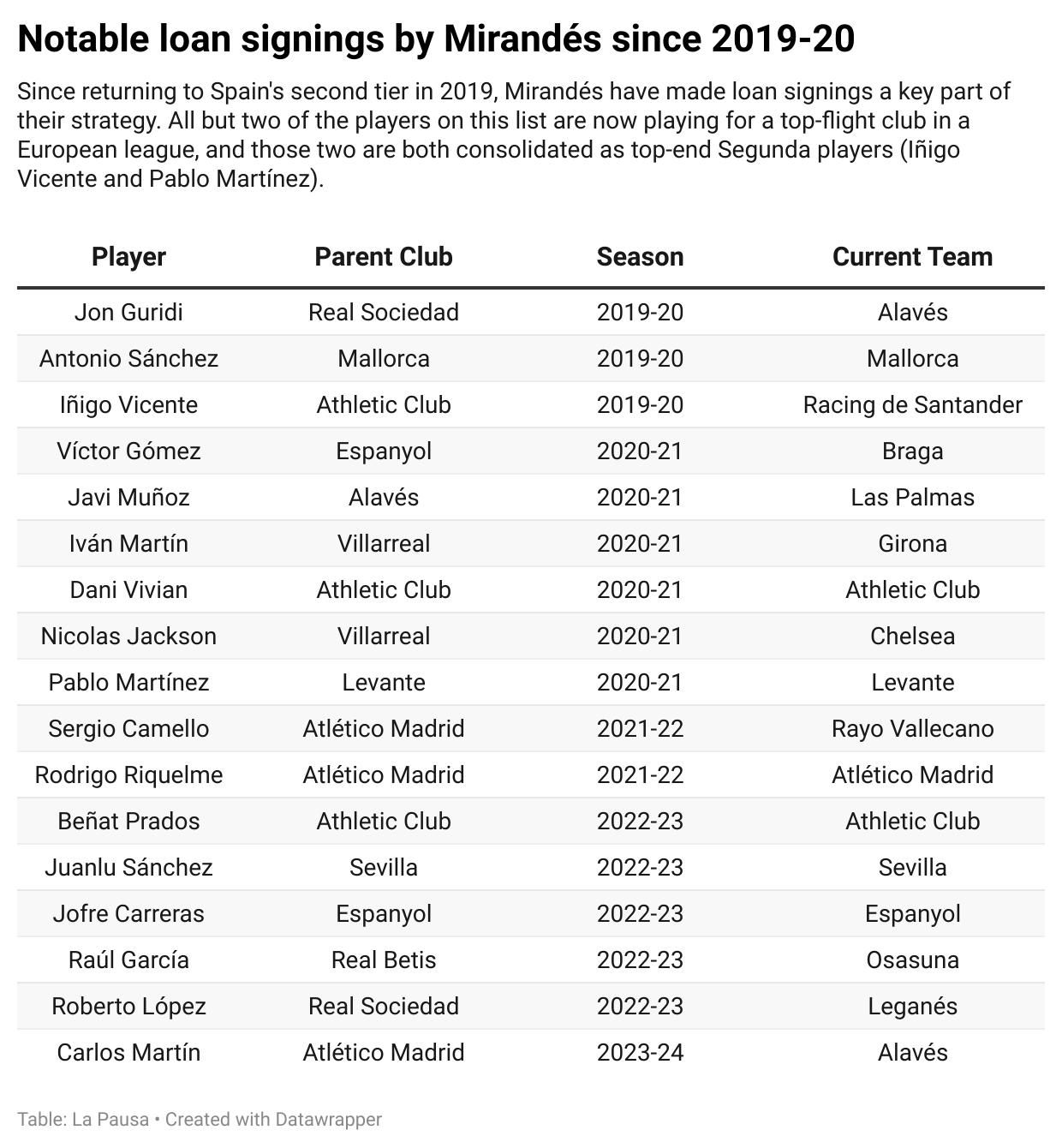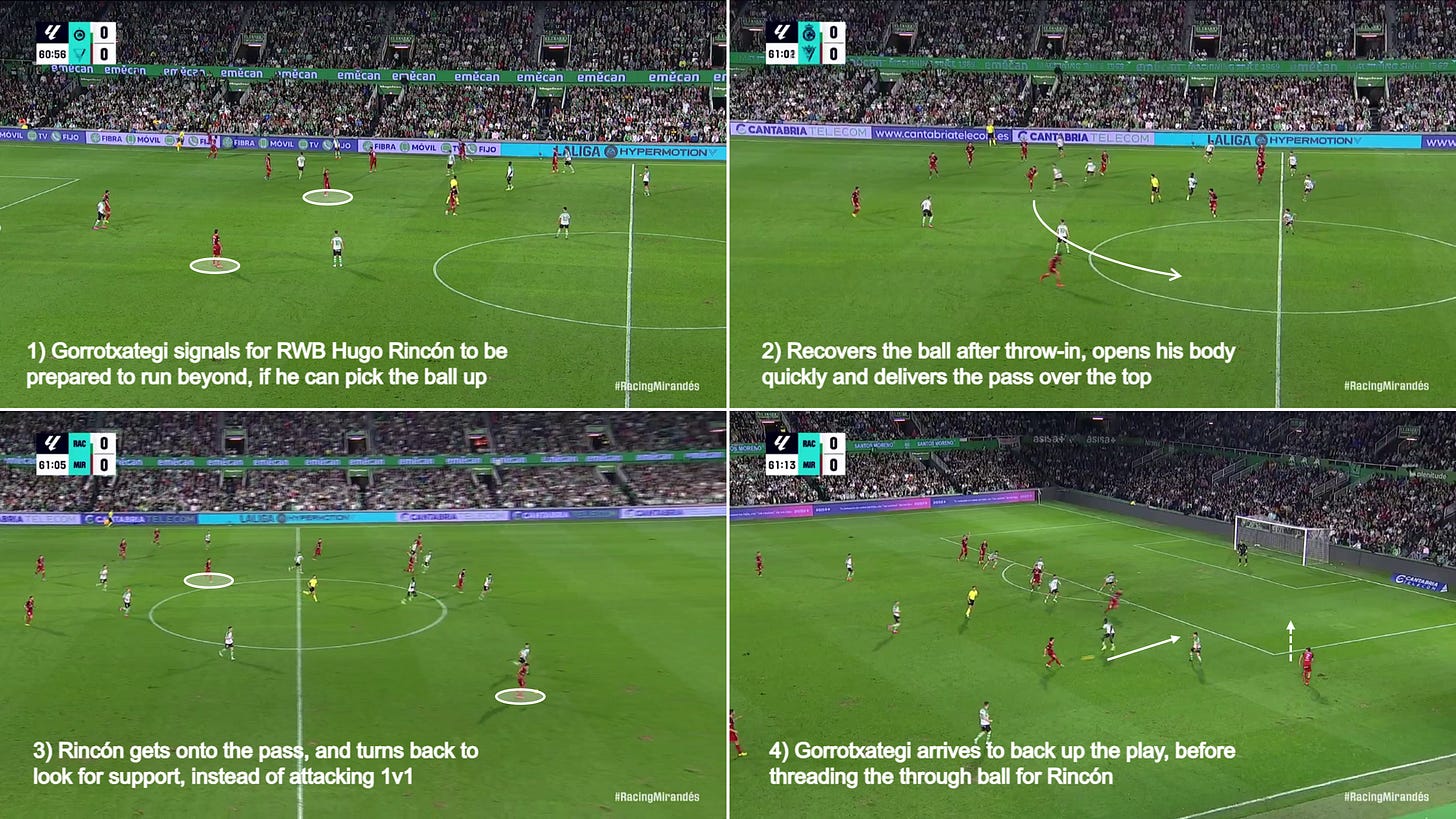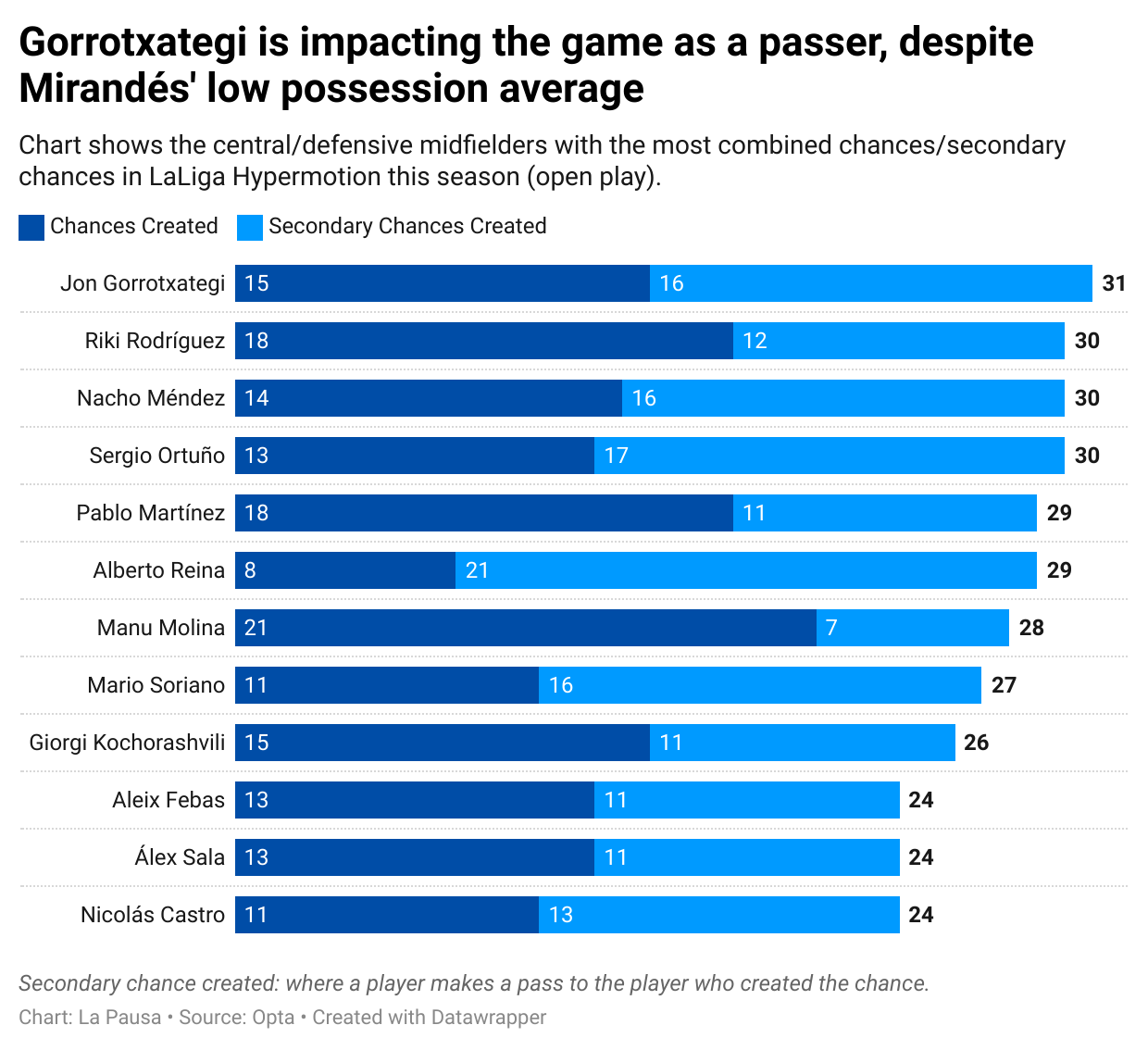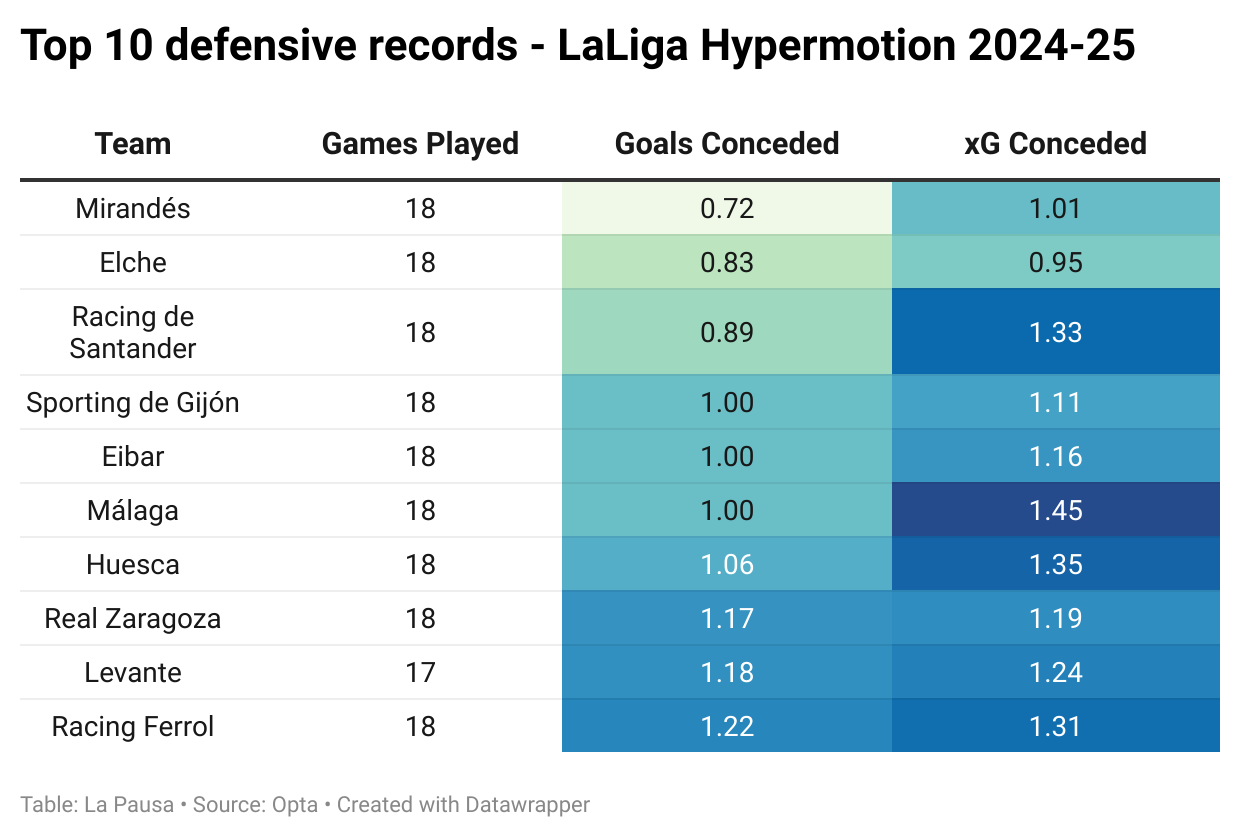Real Sociedad's post-Zubimendi plan begins to spin
Whether Martín Zubimendi stays or goes, La Real's preparation for the worst case scenario will pass through their academy.
For a while, Martín Zubimendi was a pretty well-kept secret of Spanish football. His style leant itself to quiet acclaim, and his development from one season to the next was so considered, so gradual in its precision, as to feel rare in modern football.
From the moment he entered Real Sociedad’s first team, Zubimendi’s progression occurred in remarkably linear fashion. The seasons ticked by, experience accumulated, and each summer arrived a player 5-10 percent better than he was the previous year. There were no seismic leaps, but nor were there any troughs. The 25-year-old just eased himself into becoming one of the best pivotes in the world.
Of course, the key variable – beyond Zubimendi’s ability – was the environment in which things played out. Real Sociedad are one of the rare clubs of European football who work sustainably, committing to – and even prioritising – the development and opportunity for academy players. At the same time, they achieve it against the backdrop of competing both domestically and in European competition. There is no trade-off when it comes to balancing the two – if anything, it serves to explain the latter.
Real Sociedad operate with the idea that academy and homegrown players should always outnumber those in the first team who aren’t, with the ratio often said to be around 60-40. As former Sporting Director Roberto Olabe once said: “We form [players], and we sign. To the extent that we form more and better, we’ll have less necessity to sign.”
Five years on, and 208 appearances later, Real Sociedad now find themselves nearing the end of the process with one of those they have formed as well as anyone.
After standing firm in the face of Liverpool in the summer, Zubimendi is likely to be back in the same situation in the next. Nothing in his performances, his suitability, or his injury record stand to dissuade those who will be interested. And with each passing season, La Real have to put a little more faith in loyalty and identity being their saving grace.
Zubimendi could end his career tomorrow and he’d still be the name on the wall at Zubieta; an eternal example of what was possible for those starting where he did. Indeed, his rise has been less a story of intention than it has been of possibility. La Real never set out to create a world class footballer – he was just one of many seeds they planted, gave every chance to, who happened to grow beyond reasonable expectation.
He has now exceeded the realistic life cycle of an academy footballer at the club, going from step one all the way to the present, where he figures as one of the best on the planet in his position. And with that, closer than ever to the end.
The midfield panorama begins to clear
While the issue of what to do if and when Zubimendi leaves grows in urgency, Real Sociedad’s academy is already showing signs of a response. Just recently we had the 2030 extension for Beñat Turrientes, which was instructive in itself. And along with that, further signals are pinging from down in the second tier of Spanish football, some 100 kilometres southwest of San Sebastián.
In a game where players seem to arrive younger and younger, and in one where 17-year-olds in Lamine Yamal and Pau Cubarsí are already among the best players in the country, 22 might seem like a bit of a late start. For Jon Gorrotxategi and Real Sociedad, however, everything is going just to plan.
Three months into his first test outside of Real Sociedad, the Mirandés loanee is playing anything like a rookie. In fact, in what is his first ever season at the professional level, he can lay claim to being one of the best midfielders in Spain currently playing outside of LaLiga. And let’s just say it wouldn’t be the first time Mirandés have hit the loan jackpot in recent years, with the parent club all the better for it.
Were you to take a look at his pass completion rate in isolation, you wouldn’t imagine Gorrotxategi to be one of that most deft midfielders in the division. Out of the 103 midfielders to have played 500+ minutes in the second tier this term, his 83 percent completion ranks 41st, and only narrowly above the league-average for his position.
In other words, we can’t talk about Jon Gorrotxategi without first stopping by the context he finds himself in.
Mirandés – as you may have heard – are having somewhat of a miracle season so far. After beginning 2024-25 by cancelling friendlies for the fact of not having enough players to pick from, they currently occupy one of the two automatic promotion spots to LaLiga. If someone were to do the calculation now, the ratio between their budget and performance would likely break the scale.
They’re also a very direct team. Mirandés rank second-last for average possession (42.6%), and they average a league-low 2.5 passes per sequence of play. In their 3-5-2 system, they play with energetic wing backs and two centre forwards (including the league’s best target man), which means plenty of advancing the ball. Unless they’re playing a team who actively drop in (a la Cartagena), Alessio Lisci’s side aren’t thinking of racking up passes in the first two thirds.
Though Gorrotxategi would almost certainly prefer a style that allowed him more contact with the ball and more considered possessions, it is simply the context he finds himself in. The construction of the squad lends itself to a certain way of playing, and that means necessary adaptation. The good news, however, is that the 22-year-old is passing the test with flying colours, showing he can provide value in a different scenario and at a different level – even if his pass completion rate is a little lower than he’d like.
Within his current context, Gorrotxategi is the relief to Mirandés’s active style. He serves to settle them when they need it, dials back the thrust when required, and helps them navigate the game with the ball with as much precision as he can impart.
What stands out about Gorrotxategi, primarily, is his processing of the game. The wheels in his mind spin quickly, and there’s little lag between his head and his feet. How much of that is natural and how much of it is acquired is difficult to say, but either way, it seems a product of a strong development, no doubt emanating from his time at Zubieta.
Even when time and space is at a shortage – particularly if it happens to be a game lacking control – Gorrotxategi has a useful habit of grounding the play again, and promoting avenues for Mirandés to begin possession with purpose. For his team, that means sprinkling in enough spells of football to compliment their direct play. As for Gorrotxategi himself, it serves as somewhat of a defence mechanism, where his elevated intelligence and technique allows him to wrestle back some of his own style of play, and mix in what he does best with the more global style of his team.
From his central midfield role in the 3-5-2, Gorrotxategi has become the clear conductor of play for Mirandés. He leads the team in touches per 90 (60), offers close support to their centre backs, and helps the team to progress the ball from one half to the other, navigating the usual obstacles in the way. Some weeks that can be harder than others, with the team skewing a little too far towards the direct end of the spectrum. But as much as is possible, Gorrotxategi tries to get the team playing.
“I’d define myself as a team player – one who helps his teammates a lot. And especially, someone who likes the ball; likes to ask for [it], get close, pick it up, start the play off. I don’t think I’m a physical type, I’m not very fast. But I think I’m an intelligent player, one who helps his teammates and likes to associate a lot.”
Jon Gorrotxategi (November 17th, Mundo Deportivo)
A big part of his success there, when it isn’t always easy, comes through a wide range of tools in evading danger. The Eibar native uses his body to disguise the ball, escapes with good acceleration, and he knows when and how to dribble himself into a better passing opportunity. Along with leading all defensive and central midfielders for successful take-ons in LaLiga Hypermotion this season (24), he pairs that with a very healthy 63 percent take-on success rate; the second highest across the two positions.
These escapes are a fixture of Gorrotxategi’s game. When the immediate and clear passes aren’t on after receiving the ball, or if he recovers it in a dead-end of an alley, the 22-year-old has the smarts to work his way into better scenarios.
In the clip below, note how he denies Racing’s counter-pressing opportunity by holding onto the ball. When a pass back to Raúl Fernández – the likeliest option – would have ended in the goalkeeper having to clear it long, Gorrotxategi feints back out of Racing’s pressure and sorts his feet out quickly to find Julio Alonso.
(Note the frustration when he doesn’t receive the pass back, which would have allowed them to escape onto the other side of the field via a crafty one-two).
And again, later in on the same game. In stoppage time away to the league leaders, and with his 10-man team defending a 1-0 lead, Gorrotxategi still isn’t done with accepting the easy way out. The average Segunda midfielder would make a different decision in that situation, but he uses that to his benefit, buying his team more time and easing the pressure against defenders who wanted a hurried clearance.
Less assured than kamikaze, Gorrotxategi simply trusts in his tools to be able to create advantages out of scenarios where he looks to have the weaker hand.
Along with his comfort in carrying the ball, the 22-year-old has found plenty of ways to impact games as a passer. Indeed, the way he flows from carrying the ball into his next pass, or from recovering the ball and moving it on with little waste, is another aspect of his game that sets him apart from the average Segunda midfielder.
Gorrotxategi’s mobility on the ball grants ways for Mirandés to escape opposition pressure, without needing groups of players around the ball to assure safe passage. Instead, he jinks his way in and out traffic, while most importantly, keeping his eyes upfield to be able to add the important final decision having opened up the space.
Like all good players of his position, his first glance is always the furthest point. Sometimes the pass is on; often it’s not. Either way, the idea is to be ready in the cases when they are.
The midfielder has formed an especially strong connection with striker Joaquín Panichelli in that sense, and the reinforcement of that only makes the runs more abundant from the Argentinean, as well as the passes even readier to go. In another example from the game against Oviedo, we see how Gorrotxategi flows through his reception and into a through ball on the last line with practically zero lag.
It’s a similar case in the clip below against Cartagena – one of the few games this season where Mirandés had to tackle a low block from the off. Having got the breakthrough at 1-0, and sensing a reactive shift up the pitch from the opponent, Gorrotxategi immediately punishes them with a sharp through ball to Panichelli to make it 2-0.
Once more, we see him rely on a quick feint to add some momentum to the possession, while denying the pass back to Unai Egiluz that Cartagena were looking for. And by the time he’s thrown the striker the other way, Gorrotxategi already has a clear view of his striker and which gap he needs to thread to find him.
Although he is nominally the most defensive of Mirandés’ midfield trio (playing in the middle with two either side of him), Gorrotxategi’s distribution has been key all across the pitch for his side. Firstly, in helping them to find their way out of initial opposition pressure when earlier, longer passes aren’t on. And then, further up the field once Mirandés have advanced with enough time for the midfielder to join in and back up their play.
Particularly in the context of how his play translates to a higher level, his quality of pass when directing the game from within the opposition half bodes well. Among all central and defensive midfielders in LaLiga Hypermotion this season, Gorrotxategi sits top of the list for chances created in open play, when combined with ‘secondary’ chances that register the pass for a player who does so with the next action.
Even without abundant opportunities of setting up in the opposition half, the 22-year-old has made his mark with plenty of efficiency when he has been able to involve himself in moves further up the pitch.
Evidently, we can’t talk about a future fit at Real Sociedad without referencing what happens without the ball. The success of Imanol Alguacil’s side in recent years, as well as Martín Zubimendi’s own, owes much to their duel-heavy, often man-to-man approach of defending. At their best, they make life brutally hard for even the most skilled possession teams in Europe.
For Gorrotxategi, projecting how he’d fit in that environment seems, admittedly, a less than convincing sell from here. Zubimendi is one of the best in the world in that lane. Comparing anyone to him – much less a youngster with no top-flight experience – is a losing battle for most of the other side.
It wasn’t always this way though. Zubimendi, too, was once the first team newbie who had to learn to survive at the professional level, and within a demanding style of play where his job was going to be especially important. Learning on the job and being guided by competition, rather than having to constantly overcome it, was an essential part of the process for the now 25-year-old. Quite simply, he didn’t come raring out of Zubieta as the dominant defensive midfielder he is today.
At Gorrotxategi’s current age, Zubimendi had 22 LaLiga starts to his name. Perhaps he simply was further along than Gorrotxa is now. There’d be no shame in that. At the same time though, age is not likely to be a defining factor in Real Sociedad’s process. Though Sporting Director Roberto Olabe – one of the key architects in their way of working – has since departed, their collective stance isn’t likely to change.
If a player arrives at 18, great. If they arrive at 24, that’s fine too.
“I always say, not at 12, not at 15, not at 17, not at 18, nor at 20 are you going to know what an architect or a stonemason will be like, so I don’t expect that of a footballer either. Like all professions, you need time to learn, in an aggressive and immediate world, exposed to public opinion, we have to have patience and commit to the development of the youngsters.”
Roberto Olabe (February 2023, Football España)
The other factor is that arriving in Real Sociedad’s first team now is different to what it was when Zubimendi did. In Imanol Alguacil’s first full season in 2019-20, La Real were coming off 12th and 9th-place finishes in the previous two campaigns. Their competitive level had dipped, hence the departure of Asier Garitano. And at the same time, club captain Asier Illarramendi was closing in on thirty, which put the succession plan for his midfield role firmly on the agenda.
Here in 2024, Real Sociedad haven’t finished outside of the top six in any of their five full seasons under Alguacil. They’ve won a Copa del Rey in that time, made it to the knockout stages in the Champions League, and had close to league-best defensive records in a number of campaigns, including leading the way for clean sheets in 2021-22.
That a player like Gorrotxategi hasn’t arrived yet can be attributed as much to the club’s current standing as it can to his own talent, or how he might compare to Zubimendi’s timeline of development. Maybe in 2024, Zubimendi himself would have had to tackle a loan spell before a place in the first team would have been granted.
Suffice to say, it’s most likely on the defensive side where Gorrotxategi’s rate of progression will be determined. The 22-year-old’s obvious selling point from here is what he can do with the ball which, in turn, calls on what he does without it to climb up to a similar level. Gorrotxa defines himself as a player who likes to have it at his feet, admitting he isn’t a particularly “physical guy” when it comes to the midfield battleground.
In any case, that’s not to say there are big red flags on the defensive end. Gorrotxategi’s immediate work has been more than adequate. The mere fact that he’s started every game in a Mirandés side with the fewest goals conceded in LaLiga Hypermotion this season is a good indicator, and his individual stats as far as defensive actions go are strong. Among defensive and central midfielders with 900+ minutes played, he ranks fourth in the division for tackles and interceptions per 90 (4.4), as well as fifth for possession recoveries per 90 (6.2). Likewise, his duel success rate features in the top 10 across the two positions (57%), while having contested more duels more than anyone on the list (217).
Gorrotxategi’s concession of lacking physicality might be a point of concern in you were looking to swap him in for Zubimendi tomorrow, but that would be based on the player of today, not the 22-year-old version. With the best will in the world, there are degrees of improvement that an individual will only have access to, and be in a position to make, once they’re on the ground in the final stop of their progression.
Speaking in 2021, at the end of his first full season at the professional level, Zubimendi was asked what things Imanol Alguacil was specifically looking for from him, in terms of improvement. “Lately, that I have to use my body [more] on the defensive end,” he said. “At times I’m too clean, and I have to learn.”
In the event that Zubimendi leaves next summer, Real Sociedad’s idea is unlikely to revolve around finding someone to replicate his role – whether that’s Jon Gorrotxategi, Beñat Turrientes, or someone currently outside of the club. We saw as much this summer when Mikel Merino was signed by Arsenal, stripping La Real not only of one of their best footballers, but one who was central to their intense, duel-heavy approach in midfield. His ‘replacement’ turned out to be Luka Sučić, which landed them with two players to accompany Zubimendi that would have been no. 10s not so long ago (Brais Méndez being the other).
For now, La Real can simply rest assured that they have another quality prospect to factor into the mix, should they be presented with another big midfield departure next summer. Much like when Ander Guevara and Zubimendi were arriving at a similar time as Asier Illarramendi’s standing began to fade, it was feasible to think both had as good a chance as each other of winning the spot. It was the latter who eventually won out, but only after that had been deduced within the “aggressive and immediate world” that Roberto Olabe once referenced.
Time, opportunity, and competition will dictate what happens in the future. The point isn’t whether Real Sociedad have a replacement for Martín Zubimendi in the oven, but that another player out of Zubieta is finding his way in professional football, and very possibly soon to be of their own benefit. Diario Vasco recently reported that La Real’s intention is for him to be part of the first team from July 2025, and the fact he has a long term contract in place (until 2027) and a €50 million release clause further helps to back up his prospects.
Jon Gorrotxategi might be the next Martín Zubimendi, with the obvious caveats included. There’s a good chance he won’t be either. But in the background, La Real will simply keep the wheels turning, giving every chance to the possibility that if he isn’t, the next man up just might be.




